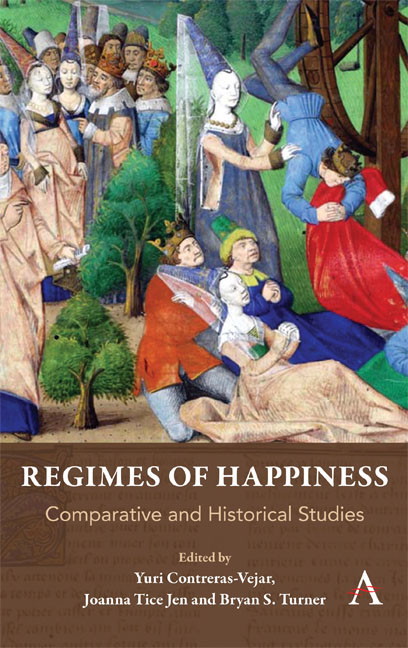Book contents
- Frontmatter
- Contents
- Acknowledgements
- Notes on Contributors
- Introduction: Reflections on Regimes of Happiness
- Part I Happiness in the West
- Part II Comparative Perspectives
- Chapter Ten And You Should Be Nothing but Happy: Judaism and the Dual Approach to Joy
- Chapter Eleven Happiness in Medieval Islamicate Literature: Conceptual and Practical Problems
- Chapter Twelve From Liberation to Happiness: The Making of Modern, Middle-Class Yoga
- Chapter Thirteen The Pursuit of Happiness in Vietnam
- Chapter Fourteen Indigenous and Western Views of Happiness: An Essay on the Politics of Contentment
- Chapter Fifteen A Nineteenth-Century Turning Point: Nietzsche, Weber, Freud and Mill
- Index
Chapter Twelve - From Liberation to Happiness: The Making of Modern, Middle-Class Yoga
from Part II - Comparative Perspectives
Published online by Cambridge University Press: 29 May 2019
- Frontmatter
- Contents
- Acknowledgements
- Notes on Contributors
- Introduction: Reflections on Regimes of Happiness
- Part I Happiness in the West
- Part II Comparative Perspectives
- Chapter Ten And You Should Be Nothing but Happy: Judaism and the Dual Approach to Joy
- Chapter Eleven Happiness in Medieval Islamicate Literature: Conceptual and Practical Problems
- Chapter Twelve From Liberation to Happiness: The Making of Modern, Middle-Class Yoga
- Chapter Thirteen The Pursuit of Happiness in Vietnam
- Chapter Fourteen Indigenous and Western Views of Happiness: An Essay on the Politics of Contentment
- Chapter Fifteen A Nineteenth-Century Turning Point: Nietzsche, Weber, Freud and Mill
- Index
Summary
Anyone can find tranquility on top of a mountain. Can you find it in the middle of Times Square?
Each summer solstice— the longest and sometimes hottest day of the year— thousands of yoga aficionados, and some novices, gather at Times Square to perform varying sequences of āsanas, or postures. The word solstice itself derives from the Latin sol (sun) and sistere (to stand still) and is of a piece with the event's stoical organizing theme: “Mind Over Madness.” If you can find peace here— in this cauldron of light and noise, the thinking goes— you can find it anywhere. And so amid the blaring horns of congested traffic, against the backdrop of garish billboards that stretch from 42nd to 48th Streets, and among the unlicensed cartoon mascots— Elmo, Minny, Hello Kitty— gawking tourists and performers like the “naked” cowboy (his guitar positioned just so), the attendees set about twisting and sweating under the midsummer sun.
“If you find your heart needing to expand into 42nd street, contract the shoulder blades,” advised a celebrity yoga instructor, her amplified words spreading through this accidental “square,” this arranged marriage of consumer excess and cultural purism. There is beauty in such images— the body as extensive as a longing love, the mind as even as a length of breath— just as there is also wishful thinking. “We‘ve turned Times Square into a temple […] Yoga is magic!” gushed another instructor who had her students doing the “cosmic wave.” The event encapsulates what is best and worst about yoga today: its demotic, everywoman appeal and its fluffy, saccharine spirituality. But as the shadows fell and the trash collected one thing became clear: The “collective ohm” the organizers envisioned did not so much challenge the atmosphere of Times Square as add to it. The major sponsor of the event, after all, was Athleta— the women's activewear division of The Gap. This was yoga finding its rightful place within the illumined spectrality of branded goods and trademarked fashions. Never had yoga been so big and never had it been so empty.
It was not always thus. Before yoga's dramatic rise to prominence, it was largely regarded as transgressive, even dangerous.
- Type
- Chapter
- Information
- Regimes of HappinessComparative and Historical Studies, pp. 187 - 200Publisher: Anthem PressPrint publication year: 2019

